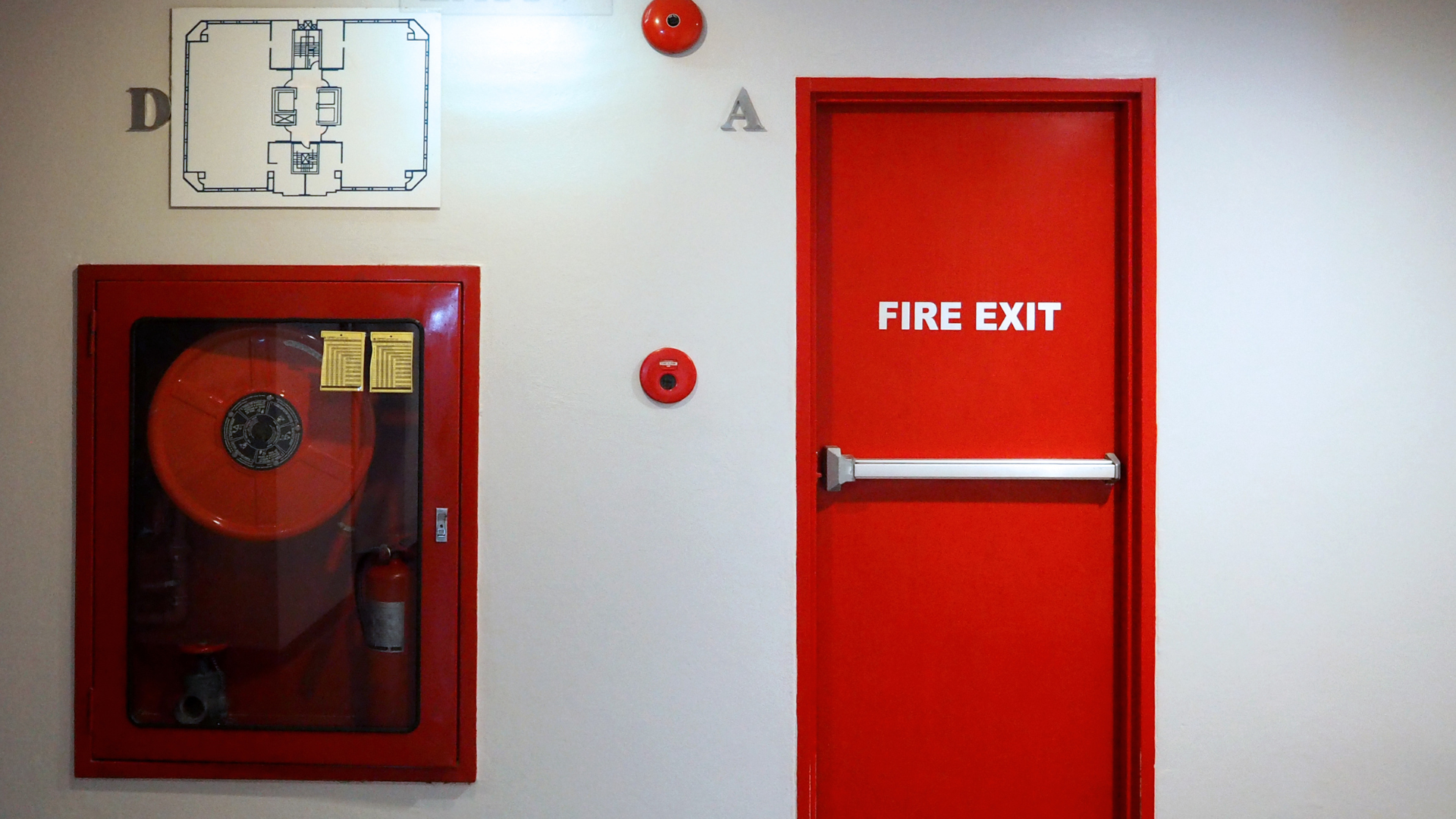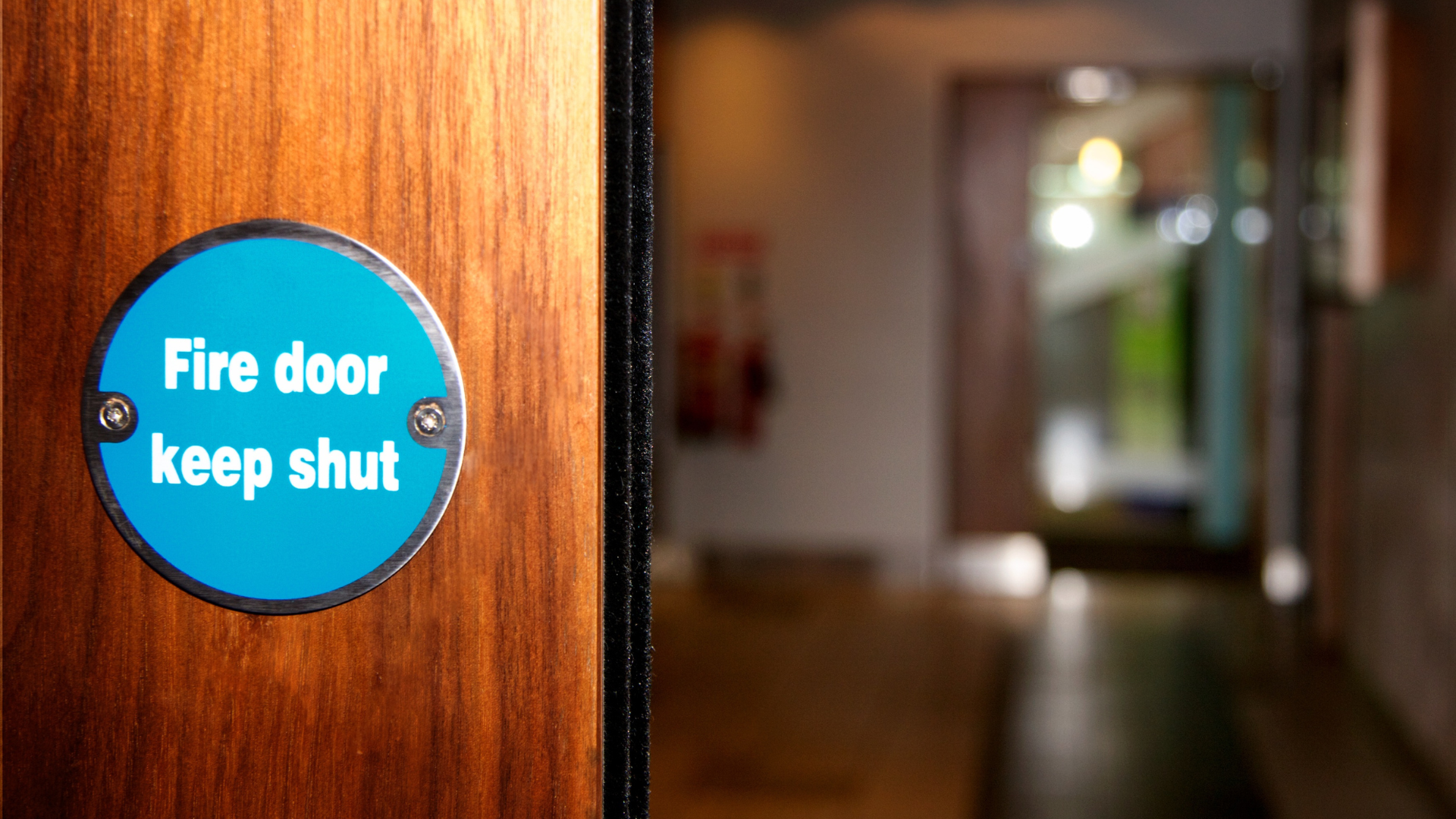Offering essential protection and containment during fires, fire doors are a crucial component of a building’s fire safety infrastructure. Nevertheless, negligent installation, maintenance and inspection can result in a risk to human life, potential irreversible damage on property and high costs for repairs.
In this blog, we’ve delved into the key aspects of fire door regulations in the UK to help you ensure that your building and its residents are well-protected.
Passive Fire Protection Systems – What Exactly Are Fire Doors?
In the year ending March 2022, there were 63,482 fires in the UK. In most of these cases, damage was limited to 2 floors or less, however, in more than 10% of these cases, the entire building sustained damage.
Fire doors are purpose-built to maintain fire compartmentation where a corridor or room passes through a protective wall. They’re made from materials that can withstand high temperatures and flames and are typically equipped with self-closing devices to maintain integrity as a fire barrier.
Fire doors often include specific hardware like fire-rated locks and door handles. To effectively provide a fire safe barrier between compartments, their capabilities extend to the frame of the door too.

Understanding The Importance Of Fire Door Regulations
Internal fire doors play a critical role in compartmentalising buildings, halting the spread of fire and smoke, establishing secure pathways for evacuation and affording occupants time to retreat during a fire emergency. However, their effectiveness isn’t guaranteed by installation alone.
Instead, as set out by the Regulatory Reform (Fire Safety) Order 2005, fire doors must be managed by your building’s ‘Responsible Person’, and meet strict guidelines to ensure their success rate. Failure to meet these requirements isn’t only illegal; it could put your building, its contents and residents at risk during an emergency.
The Crucial Role Of Fire Door Certification
In the UK, every fire door must undergo rigorous testing to adhere to either BS 476 or its European counterpart, BS EN 1634. These certifications demonstrate that the door has been tested under controlled conditions, and provide assurance that your investment is a reliable defence mechanism rather than a potentially ineffective one.
Navigating BS 476 & BS EN 1634 Fire Door Certification Standards
Outlined in the UK government’s ‘Fire Safety: Approved Document B’, BS 476 and BS EN 1634 provide the framework for the British standard for fire doors. They both offer a comprehensive framework for assessing both performance and resistance, but rely on a slightly different approach.
- BS 476 – This long-standing fire safety standard outlines fire tests for structural elements, including doors, evaluating their integrity, insulation and stability during a fire. When you come across a fire door with a BS 476 certification, you can feel safe in the knowledge that it has been widely tested and proven effective in fire scenarios.
- BS EN 1634 – This modern standard aligns with European norms and regulations, relying on a series of fire tests that examine factors like thermal insulation, integrity and radiation. This standard offers a comprehensive evaluation of a fire door’s performance in fire conditions.
Key Regulations For Fire Doors In The UK
The BS 476 and BS EN 1634 certification labels are key regulations for fire doors in the UK. Often found at the top or side of the door, these labels play a crucial role in conveying essential information about its manufacturer and compliance with recognised British standards. However, there are more regulations to consider, including;
- Intumescent seals around the fire door edges. These expand when exposed to heat to create an effective barrier against smoke and flames.
- Self-closing mechanisms, usually situated at the top of the door. This mechanism ensures that the door automatically returns to a closed position, playing a pivotal role in containing fire and smoke in the event of an emergency.
Fire doors are also assigned a fire rating. Typically ranging from 30 to 120 minutes, this indicates the duration that the door can withstand fire.

Physical Characteristics Of A Compliant Fire Door
In addition to regulatory guidelines, certain physical characteristics will ensure your fire door’s compliance. Fire doors are typically 10mm thicker than standard ones. This added thickness bolsters their resistance to heat and flames. They must feature a solid core made of materials such as timber, and may even incorporate smoke seals in addition to intumescent seals,
Your fire door must be equipped with fire-rated hinges, locks and handles designed to endure high temperatures, and should always maintain the correct gap clearance around the frame as per local regulations. Moreover, their glazing must be pyro-rated, and any letter boxes installed in the door must feature intumescent sleeving.
Effective Fire Door Installation
Now that you can measure whether your fire door is built in compliance to regulation with current UK guidelines, can you ascertain that it’s installed correctly too? Directly influencing a fire door’s capacity to fulfil its life-saving purposes, the importance of this stage shouldn’t be dismissed.
So, let’s delve into the intricacies that ensure best practices are met during the fire door installation process.
Precision For Protection
The BS 8214 regulation provides recommendations for the specification, installation and maintenance of fire doors. It states that a fire door installation demands precision above placement to provide a similar level of fire resistance as the fixed elements of a building. Here, it’s important to follow manufacturer instructions and techniques to ensure optimal functionality.
Engaging Professional Installation Services
DIY efforts serve a purpose – but fire door installation isn’t one of them! Professional installers – like those from BASSE – bring knowledge and experience to ensure flawless execution. They secure the correct fit, maintain proper clearances and seamlessly integrate the door into its designated space.
The Hardware Puzzle
A fire door’s performance during an incident relies on its installation quality. Incorrect fitting, misaligned clearances, or non-compliant hardware can render even the most certified door ineffective. But meticulous installation will form a seamless shield against the destructive forces of fire, granting occupants vital evacuation time and responders a chance to contain the blaze.
Your Fire Door Inspection Checklist
The installation of your fire door may seem like the final step in fire safety, but it’s essential to follow up with regular inspections by qualified technicians too. These inspections primarily assess the condition of the door, its frame, hinges, intumescent seals and all other fire-related hardware.
To avoid risk, however, your building’s ‘Responsible Person’ should also investigate the effectiveness of your fire doors in between inspections. To help them on their way, here’s a quick fire door inspection checklist.
- Does the door shut firmly against the frame?
- Are there any intumescent strips and/or smoke seals, and are they well-maintained?
- Is there any damage to the edge of the door or frame?
- Does the latch work as it should?
- Are there any gaps exceeding 3mm between the door and the frame?
- Is the gap at the door’s bottom more than 10mm or 3mm for a smoke control door?
- Are there at least three hinges, and do they appear to be in good shape?
- Does the door display the appropriate signage?
- If the door has glazing, does it appear to be in good shape?
- Is the door jammed or kept open?
BASSE, Your Fire Door Installation Experts
Fire doors are a crucial component of a building’s safety infrastructure. But they must be designed, installed, maintained and repaired in accordance with UK regulations to ensure their effectiveness.
At BASSE, we can support you in implementing your fire door safety plan. From cradle to grave, we’ll recommend the best option for you, work with skilled passive fire protection engineers and contractors to install your fire door and provide ongoing maintenance and repairs after the fact.
Whether you’d like to schedule an inspection, install a new fire door or discuss your fire safety strategy in its entirety, contact our experienced team.






















